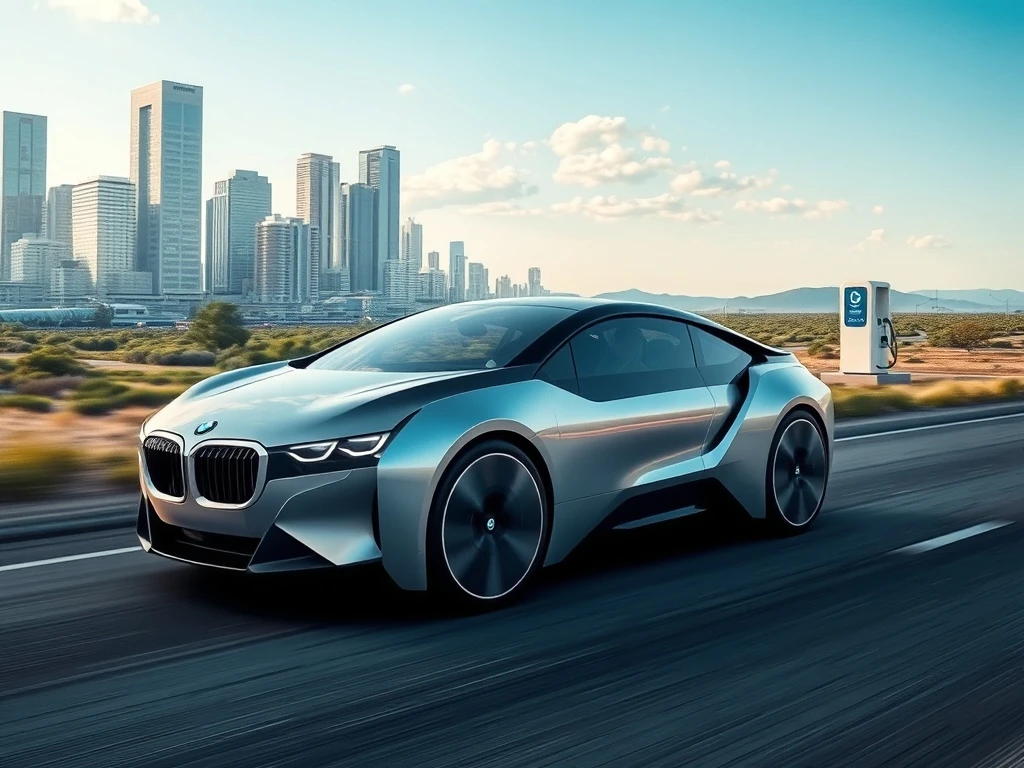Pioneering BMW Hydrogen Vehicle: A Crucial Leap for Future Mobility

In a world increasingly driven by digital innovation and decentralized solutions, the automotive industry is also charting a bold course towards a sustainable future. Just as blockchain technology promises to revolutionize finance and data, leading automakers like BMW are exploring diverse paths to decarbonization. The latest buzz? BMW’s significant commitment to the BMW hydrogen vehicle, slated for series production by 2028. This move isn’t just about adding another model to the lineup; it’s a strategic pivot, acknowledging that a single solution might not fit all in the race for greener transport. For those accustomed to the rapid evolution of crypto and blockchain, this dual-path approach to energy storage might resonate – a testament to diversified innovation.
The Dawn of the BMW Hydrogen Vehicle Era
BMW Group has made a resounding statement regarding its long-term vision for sustainable mobility: hydrogen fuel cell technology is not just a side project, but a core component of its future strategy. The announcement of a series production hydrogen-powered vehicle by 2028 places BMW firmly among a select group of manufacturers who see hydrogen as a viable, complementary solution to battery electric vehicles (BEVs). This isn’t about replacing BEVs, but rather enhancing the overall decarbonization portfolio, offering consumers more choices in their journey towards zero-emission driving.
The groundwork has already been laid with the iX5 Hydrogen prototype, a testament to BMW’s engineering prowess. Based on the popular X5 model, this prototype has demonstrated competitive performance, showcasing key advantages such as incredibly rapid refueling times – think minutes, not hours – and, crucially, zero tailpipe emissions. While the final production model’s design and specifications are still under wraps, the iX5 Hydrogen has provided a compelling glimpse into what’s possible.
Why Hydrogen? Addressing BEV Limitations with Hydrogen Fuel Cell Technology
For years, the narrative around electric vehicles has largely focused on BEVs. While their adoption has soared, challenges persist, particularly concerning charging times and range anxiety. This is where hydrogen fuel cell technology enters the conversation as a powerful alternative. Jürgen Guldner, BMW’s General Project Manager for Hydrogen Technology and Vehicle Projects, articulates this perfectly: “A hydrogen vehicle is an electric vehicle—it’s just a different way of storing energy.”
This simple yet profound statement highlights a critical synergy. Hydrogen vehicles utilize electric motors, much like BEVs, but they generate electricity onboard through a chemical reaction between hydrogen and oxygen, with water as the only byproduct. The stored energy is in the form of compressed hydrogen gas, allowing for a refueling experience that mirrors gasoline cars: a quick 3-4 minute fill-up. This stark contrast to the often lengthy charging times of BEVs makes hydrogen particularly appealing for:
- Drivers requiring extended range without frequent stops.
- Commercial fleets where vehicle downtime must be minimized.
- Regions with limited fast-charging BEV infrastructure.
BMW’s strategy is rooted in pragmatism. They recognize that while BEVs suit many, they don’t cater to every consumer’s lifestyle or every operational need. By investing in hydrogen, BMW aims to offer a truly diversified decarbonization portfolio, ensuring that more people can transition to zero-emission transport without compromising on convenience or capability.
Navigating the Infrastructure Maze: The Challenge for BEV Infrastructure and Hydrogen
While the technological promise of hydrogen is clear, the path to widespread adoption is fraught with significant hurdles, primarily in infrastructure development. The disparity between BEV infrastructure and hydrogen refueling networks is stark. Globally, BEV charging stations have proliferated at an astonishing rate, becoming increasingly accessible in urban centers, highways, and even residential areas.
Consider the UK as a case in point: in 2019, it boasted 15 hydrogen stations; by 2025, this number dwindled to a mere four. In stark contrast, the UK now has 39,733 public BEV charging locations. This vast difference underscores the scale of the challenge for hydrogen. Building hydrogen refueling stations is considerably more expensive, with costs ranging from $1.5 million to $4 million per station, compared to $1,000–$50,000 for BEV chargers. This cost differential is a major barrier to rapid expansion.
| Infrastructure Type | Typical Cost per Station/Charger | UK Public Locations (2025) | Key Advantages | Key Challenges |
|---|---|---|---|---|
| Hydrogen Refueling Station | $1.5M – $4M | 4 | Rapid refueling (3-4 min), long range, no range anxiety | High cost, sparse network, complex logistics |
| BEV Charging Location | $1K – $50K (for public chargers) | 39,733 | Widespread availability, lower installation cost, home charging convenience | Longer charging times, range anxiety, grid strain |
Despite these challenges, proponents argue that a diversified, hybrid approach—investing in both BEV and hydrogen infrastructure—could actually lead to overall cost savings. David Wong of the Society of Motor Manufacturers and Traders cited modeling suggesting that a 90% BEV and 10% hydrogen mix in Germany could save an astounding $40 billion in infrastructure costs compared to a 100% BEV network. This highlights the potential economic benefits of a dual-technology approach, optimizing grid strain and resource allocation.
The Road Ahead: Paving the Way for Sustainable Transport
BMW’s commitment to a 2028 launch hinges significantly on overcoming these infrastructure hurdles. The automaker has yet to identify specific target markets, underscoring that infrastructure readiness will be a critical determinant. Jürgen Guldner remains optimistic about future improvements: “Right now, it’s simply not here in the UK. But hopefully in the next few years, development will pick up.”
One potential catalyst for wider hydrogen adoption lies in commercial applications, particularly heavy transport. Projects like HyHAUL, focusing on long-haul trucking, demonstrate hydrogen’s economic viability where large volumes of fuel are needed and vehicle uptime is paramount. Chris Jackson of Protium Green Solutions emphasized that hydrogen’s economics scale much better for heavy transport, requiring fewer vehicles to justify significant station investments compared to passenger cars. This commercial push could create the necessary backbone for a broader passenger vehicle network, driving down costs and increasing availability.
The vision for truly sustainable transport requires a multifaceted approach. It’s not just about electric cars; it’s about optimizing energy sources, distribution, and consumption across the entire mobility ecosystem. Hydrogen, especially when produced from renewable sources (green hydrogen), offers a compelling pathway to decarbonize sectors that are harder to electrify directly, like heavy industry, shipping, and aviation, in addition to road transport.
Future Mobility: Will Consumers Embrace Hydrogen?
Despite the technological advancements and strategic corporate commitments, consumer adoption remains the ultimate test for hydrogen vehicles. While surveys often suggest a significant interest in hydrogen vehicles, actual sales figures tell a different story. In 2024, global sales of Fuel Cell Electric Vehicles (FCEVs) totaled a mere 12,866 units, dwarfed by the 10.8 million BEVs sold. This stark contrast highlights the uphill battle hydrogen faces in the consumer market.
Toyota, a long-standing leader in hydrogen technology with its Mirai model, continues to advocate for consumer choice. However, even its own Paris-based Hype taxi service, once a prominent hydrogen fleet, has shifted its focus towards BEVs. This real-world pivot underscores the immediate practical challenges of hydrogen infrastructure for widespread consumer use.
BMW’s gamble relies on a delicate balance: aligning infrastructure growth with burgeoning consumer demand. The automaker aims for price parity with BEVs through economies of scale, believing that increased production and wider availability will naturally drive down costs. The 2028 launch will serve as a critical litmus test, determining whether hydrogen can successfully transition from a niche solution, primarily for commercial or early-adopter markets, to a mainstream option for the average consumer.
Jürgen Guldner himself acknowledged the inherent uncertainty: “I am always surprised by surveys where many people say they prefer hydrogen. The question is whether these preferences translate into sales.” The success of BMW’s hydrogen initiative will undoubtedly depend on coordinated industry efforts, significant governmental support for infrastructure development, and, ultimately, consumer willingness to embrace a dual-technology future where hydrogen plays a vital, complementary role alongside battery electric vehicles in achieving comprehensive future mobility goals.
Conclusion: A Bold Bet on a Diversified Future
BMW’s announcement to launch a hydrogen vehicle into series production by 2028 marks a significant and bold step in the evolution of sustainable transport. It underscores a pragmatic recognition that a singular approach to decarbonization may not be sufficient for the diverse needs of global consumers and industries. By embracing hydrogen fuel cell technology alongside its robust BEV program, BMW is championing a diversified portfolio aimed at addressing key challenges like range anxiety and refueling times.
While the path is undeniably challenging, particularly concerning the massive investment required for hydrogen infrastructure development, the potential benefits—from rapid refueling to optimized energy grids—are compelling. The synergy between commercial hydrogen applications and passenger vehicle adoption could prove crucial in building the necessary ecosystem. The success of this initiative will not only depend on BMW’s engineering prowess but also on a collaborative effort across industries and governments to foster the required infrastructure and, most importantly, on consumers’ willingness to adopt this exciting new facet of zero-emission driving. BMW’s 2028 launch will be a pivotal moment, shaping the narrative for a truly comprehensive and sustainable future of mobility.
Frequently Asked Questions (FAQs)
Q1: What is BMW’s main goal with launching a hydrogen vehicle?
A1: BMW aims to complement its battery electric vehicle (BEV) offerings with hydrogen fuel cell technology. This strategy seeks to diversify its decarbonization portfolio, providing solutions for consumers who prioritize rapid refueling and extended range, addressing common BEV limitations like charging time and range anxiety.
Q2: How does a hydrogen vehicle differ from a battery electric vehicle (BEV)?
A2: Both hydrogen vehicles and BEVs are electric vehicles, meaning they are powered by electric motors and produce zero tailpipe emissions. The key difference lies in energy storage. BEVs store electricity in large batteries that are charged externally. Hydrogen vehicles generate electricity onboard by converting hydrogen gas into electricity via a fuel cell, with water as the only byproduct, allowing for quick refueling similar to gasoline cars.
Q3: What are the biggest challenges facing hydrogen vehicle adoption?
A3: The primary challenge is the lack of robust hydrogen refueling infrastructure. Hydrogen stations are significantly more expensive to build than BEV charging points, leading to a sparse network. Consumer awareness and willingness to adopt a new technology also remain hurdles, as reflected in lower FCEV sales compared to BEVs.
Q4: How could hydrogen infrastructure development be accelerated?
A4: Experts suggest that a hybrid approach, investing in both BEV and hydrogen infrastructure, could be more cost-effective overall. Additionally, the scaling of hydrogen for commercial heavy transport (e.g., trucks) could help build out the initial network, as the economics for larger vehicles justify the investment more readily, potentially paving the way for passenger car adoption.
Q5: Will hydrogen vehicles become as common as BEVs in the future?
A5: While surveys show consumer interest, current sales figures indicate a significant gap. The success of hydrogen vehicles, like BMW’s 2028 launch, depends heavily on the rapid development of infrastructure, achieving price parity with BEVs through economies of scale, and widespread consumer acceptance. They are currently positioned as a complementary solution rather than a direct replacement for BEVs.








